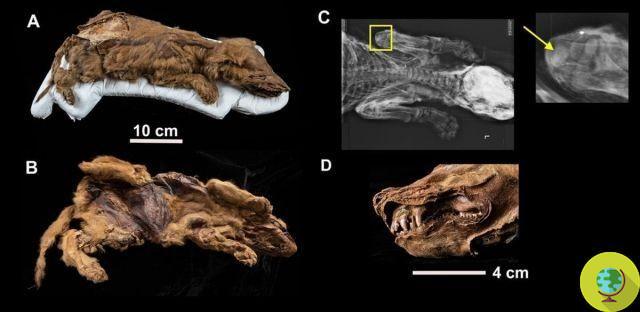It was buried in the permafrost for 57 years. He was only seven weeks old when the young gray wolf discovered in the Yukon died
He is about to end up run over, his mother saves himThe preserved cub is helping researchers understand how wolves migrated across Europe, Asia and North America
He was buried in the permafrost for well 57 thousand years. He was only seven weeks old when the young man died gray wolfor discovered in the Yukon, Canada. A rarity since it is almost intact. The cold preserved its body, but global warming brought it back to light.
A discovery that makes us rejoice given the exceptional nature of the event but which once again demonstrates the impact of climate change. The body of the little gray wolf was identified by an international team of scientists including researchers from Des Moines University and those from the University of Alaska Fairbanks. According to the authors, it is a gray wolf cub, a population that arrived in the Yukon region by migrating from Siberia via the Bering land bridge.
However, the animal was identified by a miner looking for gold. As water poured out of a frozen mud wall in the Yukon, Canada, man noticed the perfectly preserved wolf pup that had been trapped in permafrost for 57.000 years. The cub's extraordinary condition, named Zhùr by the local people of Tr'ondëk Hwëch'in, provided researchers with a wealth of information about its age, lifestyle and relationship with modern wolves. The findings were published yesterday in the journal Current Biology.
“It is the most complete wolf mummy that has ever been found. It's virtually 100 percent intact, all that's missing are the eyes, ”said lead author Julie Meachen, an associate professor of anatomy at Des Moines University. "And the fact that it is so complete has allowed us to do so many lines of investigation to fundamentally reconstruct its life."
How it managed to remain intact for almost 60 years
One of the most important questions about Zhùr that the researchers have tried to answer is how it remained in permafrost for so long and remained virtually intact. In fact, it takes a series of circumstances to find such a well-made mummy in the permafrost.
“It is rare to find these mummies in the Yukon. The animal has to die in permafrost, where the ground is always frozen, and they have to be buried very quickly, like in any other fossilization process, ”says Meachen. "If it stays too long in the frozen tundra, it will rot or be eaten."
Another important factor concerns the wolf's death. Animals that die slowly or are hunted by predators are less likely to be found in good condition.

©Des Moines University
“We think he was in his lair and died instantly from a collapse,” says Meachen. "Our data showed that he didn't starve and was around seven weeks old, so we feel a little better knowing the puppy didn't suffer for long."
In addition to learning how Zhùr died, the team was also able to analyze his diet. Apparently, it was heavily influenced by its proximity to water.
Normally, when you think of wolves in the ice age, you think of them eating bison or musk oxen or other large animals on land. One thing that surprised us was that he was eating aquatic resources, especially salmon. "
The analysis of Zhùr's genome also confirmed that the animal was descended from ancient wolves from Russia, Siberia and Alaska, the ancestors of modern wolves. Although Zhùr's analysis has given researchers many answers about wolves of the past, some questions remain.
“We were asked why he was the only wolf found in the den and what happened to his mother or siblings,” says Meachen. “It may have been the only puppy. Or the other wolves weren't in the lair during the collapse. Unfortunately, we will never know. "
The specimen has special significance for the local people of Tr'ondëk Hwëch'in, who have agreed to put Zhùr on display at the Yukon Beringia Interpretation Center in Whitehorse.
The mummy, cleaned and preserved, will remain so for years to come, and will move to other locations in the Yukon.
"A small positive aspect of climate change is that we will find more mummies as permafrost melts," says Meachen. “This is a good way for science to better reconstruct that period, but it also shows us how much our planet is actually warming. We really have to be careful. "
Sources of reference: University of Alaska Fairbanks, Des Moines University, Current Biology
READ also:
- Alaska's new climate threat: tsunamis caused by melting permafrost
- Ice Age cave bear found in Russia after permafrost melting
- Found horse 40 thousand years ago: it was hidden in the Siberian permafrost


























